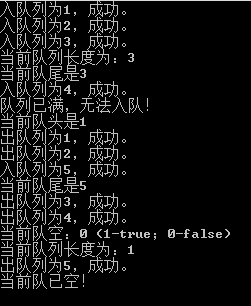题目
- 原文:
Implement a StackQueue class which implements a queue using two stacks. - 译文:
使用两个栈实现一个队列StackQueue。
分析
- 这里代码设计两个栈最大长度等长,当然也可以不等长;
- 将两个栈功能上划分为一个负责入栈(m_sin),一个负责出栈(m_sout);
- 入队列时,直接将元素压入m_sin,当m_sin栈满但m_sout栈未满时,先将m_sin中的元素出栈并压入m_sout,留出位置入栈;
- 出队列时,若m_sout栈非空直接从m_sout出栈,否则先将m_sin中的元素出栈并压入m_sout。
- 取队顶元素时,若m_sout栈非空直接从m_sout栈顶取,否则先将m_sin中的元素出栈并压入m_sout。
- 取队尾元素时,若m_sin栈非空直接从m_sin栈顶取,否则先将m_sout中的元素出栈并压入m_sin。
- 实际上,可以将两个栈看成是将一个队列从中间切开后,m_sin栈从栈顶到栈底对应队列的队尾到切开处, m_sout栈从栈顶到栈底对应队列的队首到切开处。
代码
#include<iostream>
#include<stack>
using namespace std;
template <typename T>
class StackQueue {
public:
StackQueue(int MaxStackSize) {
this->maxStacksize = MaxStackSize;
}
~StackQueue() {
}
void push(T node) {
if(m_sin.size() >= maxStacksize && m_sout.size() >= maxStacksize) {
cout << "队列已满,无法入队!" << endl;
return;
}
if(m_sin.size() >= maxStacksize) {
move(m_sin, m_sout);
}
m_sin.push(node);
cout << "入队列为" << m_sin.top() << ",成功。" << endl;
}
void pop() {
move(m_sin, m_sout);
if(m_sout.empty()) {
cout << "队列已空,无法出队!" << endl;
}
else {
cout << "出队列为" << m_sout.top() << ",成功。" << endl;
m_sout.pop();
}
}
T* front() {
if (m_sin.empty() && m_sout.empty()) {
cout << "当前队已空!" << endl;
return NULL;
}
move(m_sin, m_sout);
//cout << "队列头为" << m_sout.top() << endl;
return &m_sout.top();
}
T* back() {
if (m_sin.empty() && m_sout.empty()) {
cout << "当前队已空!" << endl;
return NULL;
}
move(m_sout, m_sin);
//cout << "队列尾为" << m_sin.top() << endl;
return &m_sin.top();
}
int size() {
return m_sin.size() + m_sout.size();
}
bool empty() {
return m_sin.empty() && m_sout.empty();
}
void move(stack<T> &ssrc, stack<T> &sdst) {
if(sdst.empty() && !ssrc.empty()) {
while(!ssrc.empty() && sdst.size() < maxStacksize) {
T node = ssrc.top();
ssrc.pop();
sdst.push(node);
}
}
}
private:
stack<T> m_sin, m_sout;
int maxStacksize;
};
int main() {
StackQueue<int> queue(2);
queue.push(1);
queue.push(2);
queue.push(3);
cout << "当前队列长度为:" << queue.size() << endl;
int *pqback = queue.back();
cout << "当前队尾是" << *pqback << endl;
queue.push(4);
queue.push(5);
int *pqfront = queue.front();
cout << "当前队头是" << *pqfront << endl;
queue.front();
queue.pop();
queue.pop();
queue.push(5);
pqback = queue.back();
cout << "当前队尾是" << *pqback << endl;
queue.pop();
queue.pop();
cout << "当前队空:" << queue.empty() << " (1-true;0-false)" << endl;
cout << "当前队列长度为:" << queue.size() << endl;
queue.pop();
queue.front();
}
结果展示
